Inside Aztec
Inside
Aztec
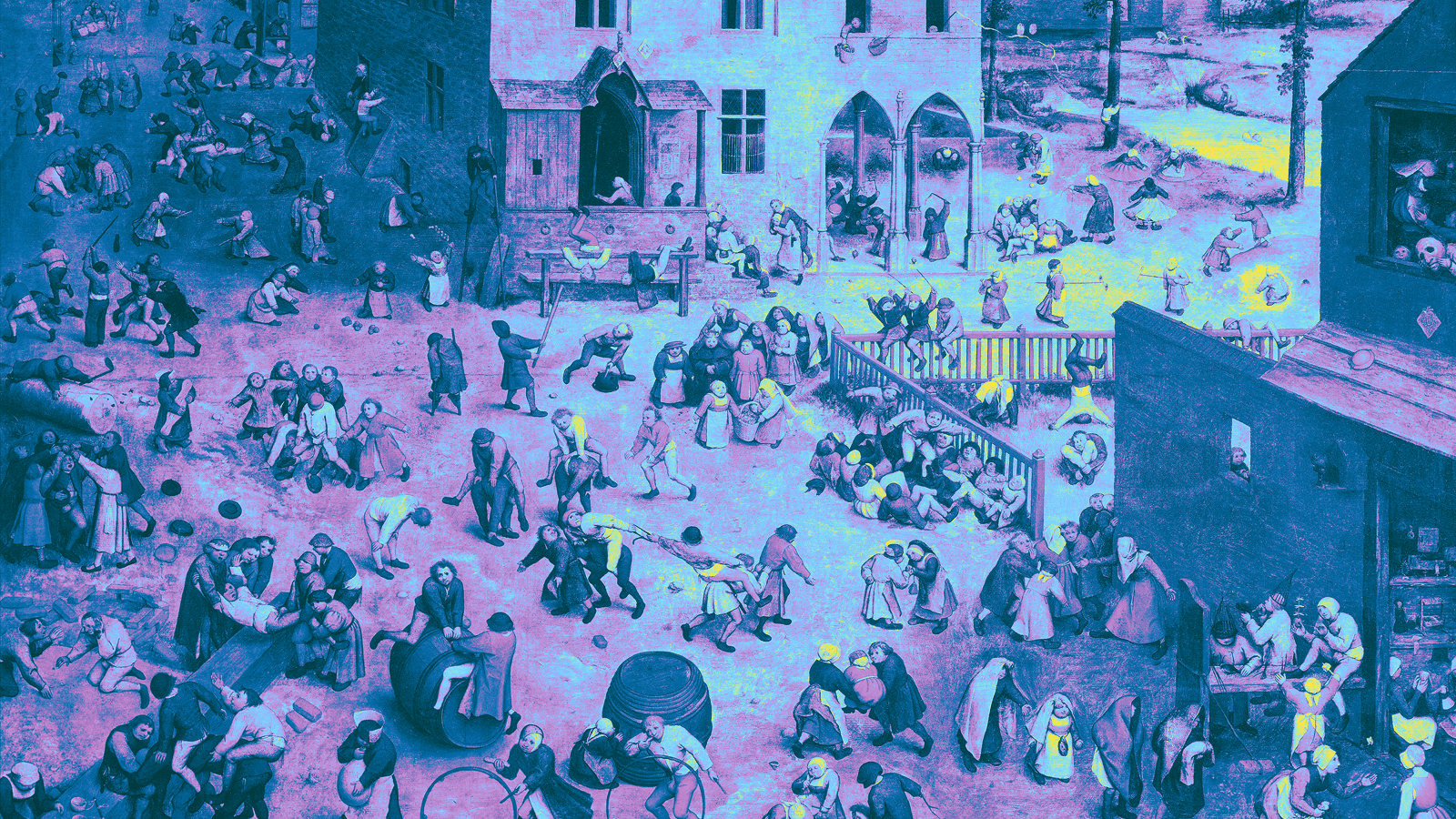

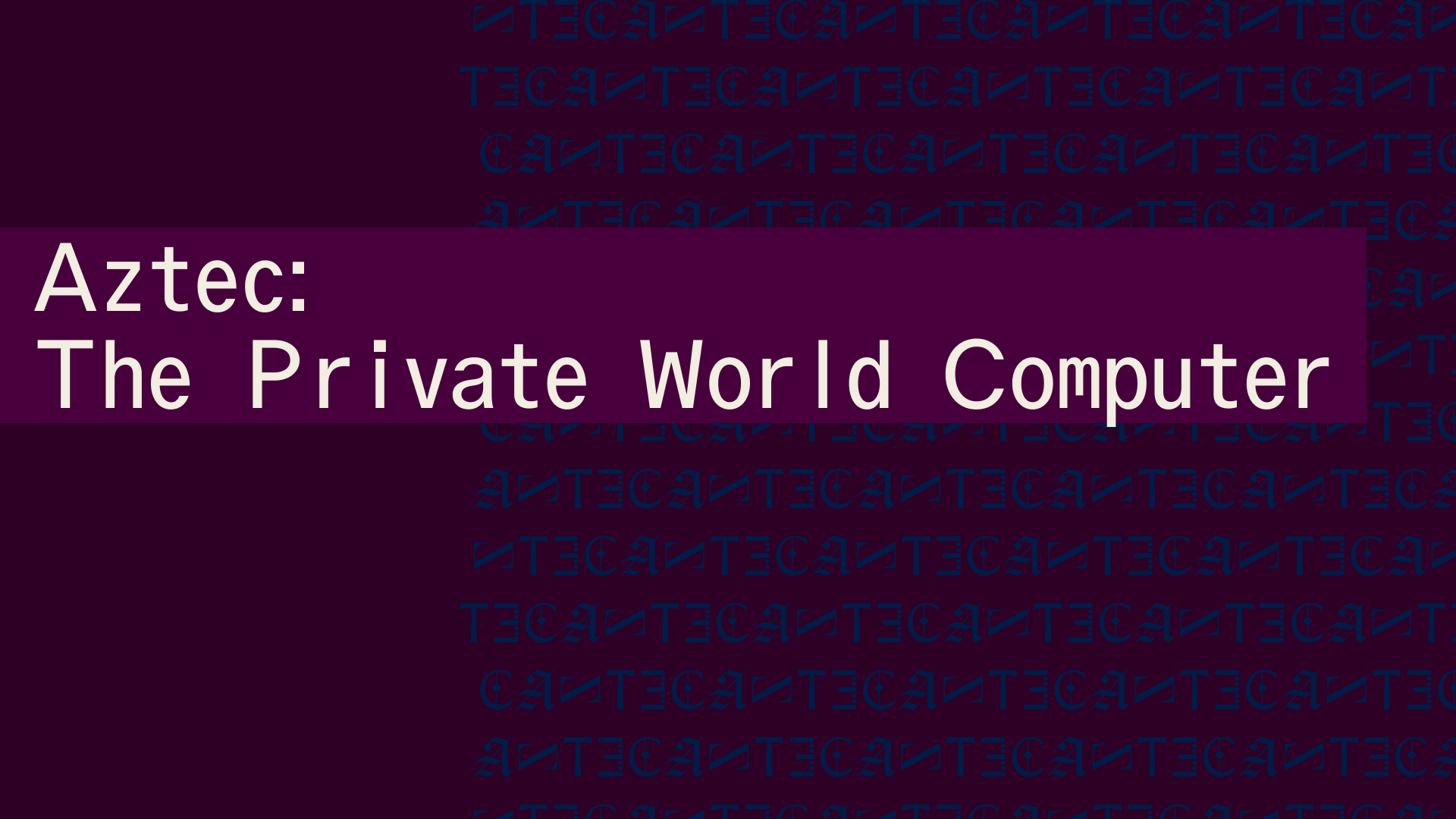
Building a fully decentralized, privacy-preserving network to unlock the next Renaissance.
Privacy has emerged as a major driver for the crypto industry in 2025. We’ve seen the explosion of Zcash, the Ethereum Foundation’s refocusing of PSE, and the launch of Aztec’s testnet with over 24,000 validators powering the network. Many apps have also emerged to bring private transactions to Ethereum and Solana in various ways, and exciting technologies like ZKPassport that privately bring identity on-chain using Noir have become some of the most talked about developments for ushering in the next big movements to the space.
Underpinning all of these developments is the emerging consensus that without privacy, blockchains will struggle to gain real-world adoption.
Without privacy, institutions can’t bring assets on-chain in a compliant way or conduct complex swaps and trades without revealing their strategies. Without privacy, DeFi remains dominated and controlled by advanced traders who can see all upcoming transactions and manipulate the market. Without privacy, regular people will not want to move their lives on-chain for the entire world to see every detail about their every move.
While there's been lots of talk about privacy, few can define it. In this piece we’ll outline the three pillars of privacy and gives you a framework for evaluating the privacy claims of any project.
True privacy rests on three essential pillars: transaction privacy, identity privacy, and computational privacy. It is only when we have all three pillars that we see the emergence of a private world computer.

Transaction privacy means that both inputs and outputs are not viewable by anyone other than the intended participants. Inputs include any asset, value, message, or function calldata that is being sent. Outputs include any state changes or transaction effects, or any transaction metadata caused by the transaction. Transaction privacy is often primarily achieved using a UTXO model (like Zcash or Aztec’s private state tree). If a project has only the option for this pillar, it can be said to be confidential, but not private.
Identity privacy means that the identities of those involved are not viewable by anyone other than the intended participants. This includes addresses or accounts and any information about the identity of the participants, such as tx.origin, msg.sender, or linking one’s private account to public accounts. Identity privacy can be achieved in several ways, including client-side proof generation that keeps all user info on the users’ devices. If a project has only the option for this pillar, it can be said to be anonymous, but not private.
Computation privacy means that any activity that happens is not viewable by anyone other than the intended participants. This includes the contract code itself, function execution, contract address, and full callstack privacy. Additionally, any metadata generated by the transaction is able to be appropriately obfuscated (such as transaction effects, events are appropriately padded, inclusion block number are in appropriate sets). Callstack privacy includes which contracts you call, what functions in those contracts you’ve called, what the results of those functions were, any subsequent functions that will be called after, and what the inputs to the function were. A project must have the option for this pillar to do anything privately other than basic transactions.
Bitcoin ushered in a new paradigm of digital money. As a permissionless, peer-to-peer currency and store of value, it changed the way value could be sent around the world and who could participate. Ethereum expanded this vision to bring us the world computer, a decentralized, general-purpose blockchain with programmable smart contracts.

Given the limitations of running a transparent blockchain that exposes all user activity, accounts, and assets, it was clear that adding the option to preserve privacy would unlock many benefits (and more closely resemble real cash). But this was a very challenging problem. Zcash was one of the first to extend Bitcoin’s functionality with optional privacy, unlocking a new privacy-preserving UTXO model for transacting privately. As we’ll see below, many of the current privacy-focused projects are working on similar kinds of private digital money for Ethereum or other chains.
Now, Aztec is bringing us the final missing piece: a private world computer.
A private world computer is fully decentralized, programmable, and permissionless like Ethereum and has optional privacy at every level. In other words, Aztec is extending all the functionality of Ethereum with optional transaction, identity, and computational privacy. This is the only approach that enables fully compliant, decentralized applications to be built that preserve user privacy, a new design space that we see as ushering in the next Renaissance for the space.
Private digital money emerges when you have the first two privacy pillars covered - transactions and identity - but you don’t have the third - computation. Almost all projects today that claim some level of privacy are working on private digital money. This includes everything from privacy pools on Ethereum and L2s to newly emerging payment L1s like Tempo and Arc that are developing various degrees of transaction privacy
When it comes to digital money, privacy exists on a spectrum. If your identity is hidden but your transactions are visible, that's what we call anonymous. If your transactions are hidden but your identity is known, that's confidential. And when both your identity and transactions are protected, that's true privacy. Projects are working on many different approaches to implement this, from PSE to Payy using Noir, the zkDSL built to make it intuitive to build zk applications using familiar Rust-like syntax.
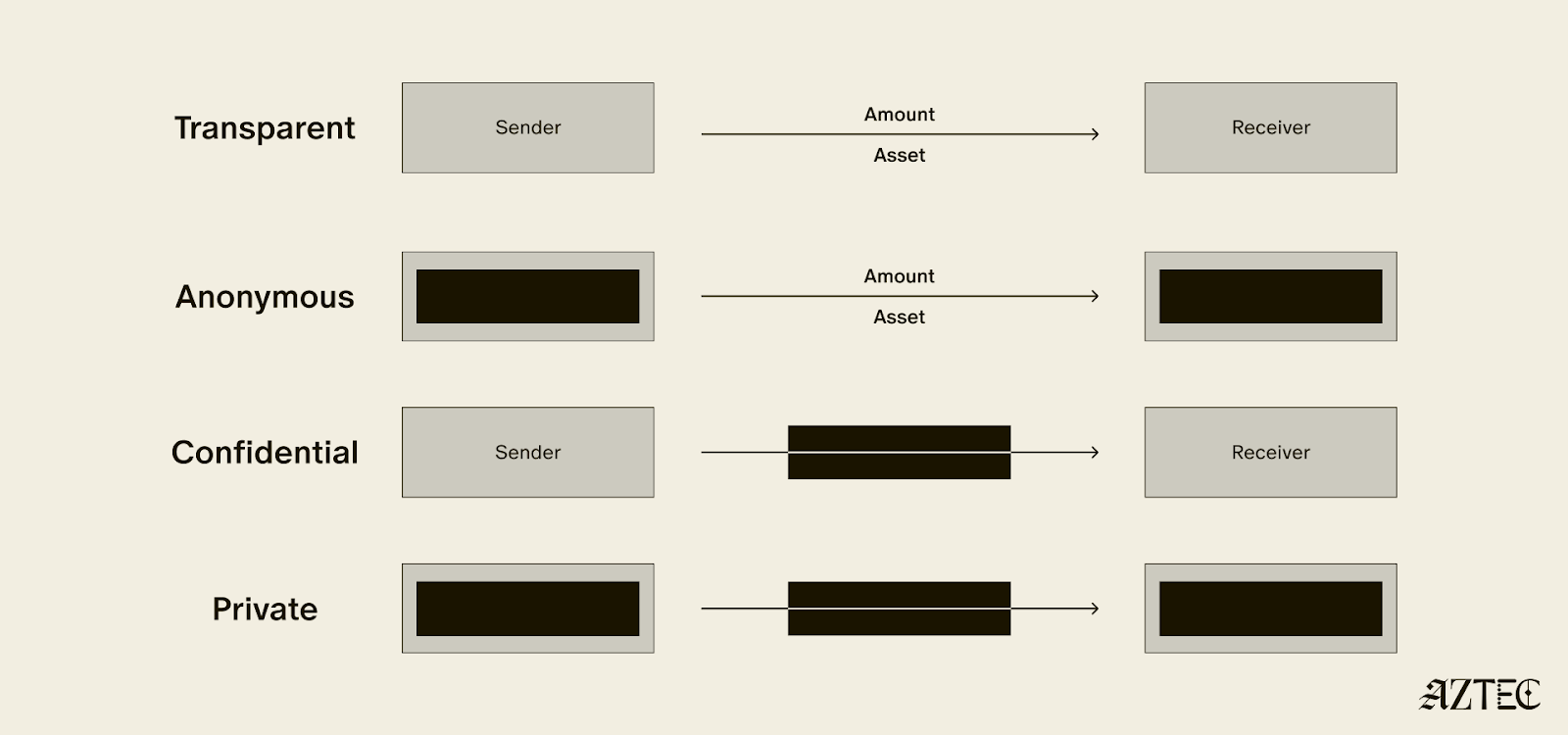
Private digital money is designed to make payments private, but any interaction with more complex smart contracts than a straightforward payment transaction is fully exposed.
What if we also want to build decentralized private apps using smart contracts (usually multiple that talk to each other)? For this, you need all three privacy pillars: transaction, identity, and compute.
If you have these three pillars covered and you have decentralization, you have built a private world computer. Without decentralization, you are vulnerable to censorship, privileged backdoors and inevitable centralized control that can compromise privacy guarantees.
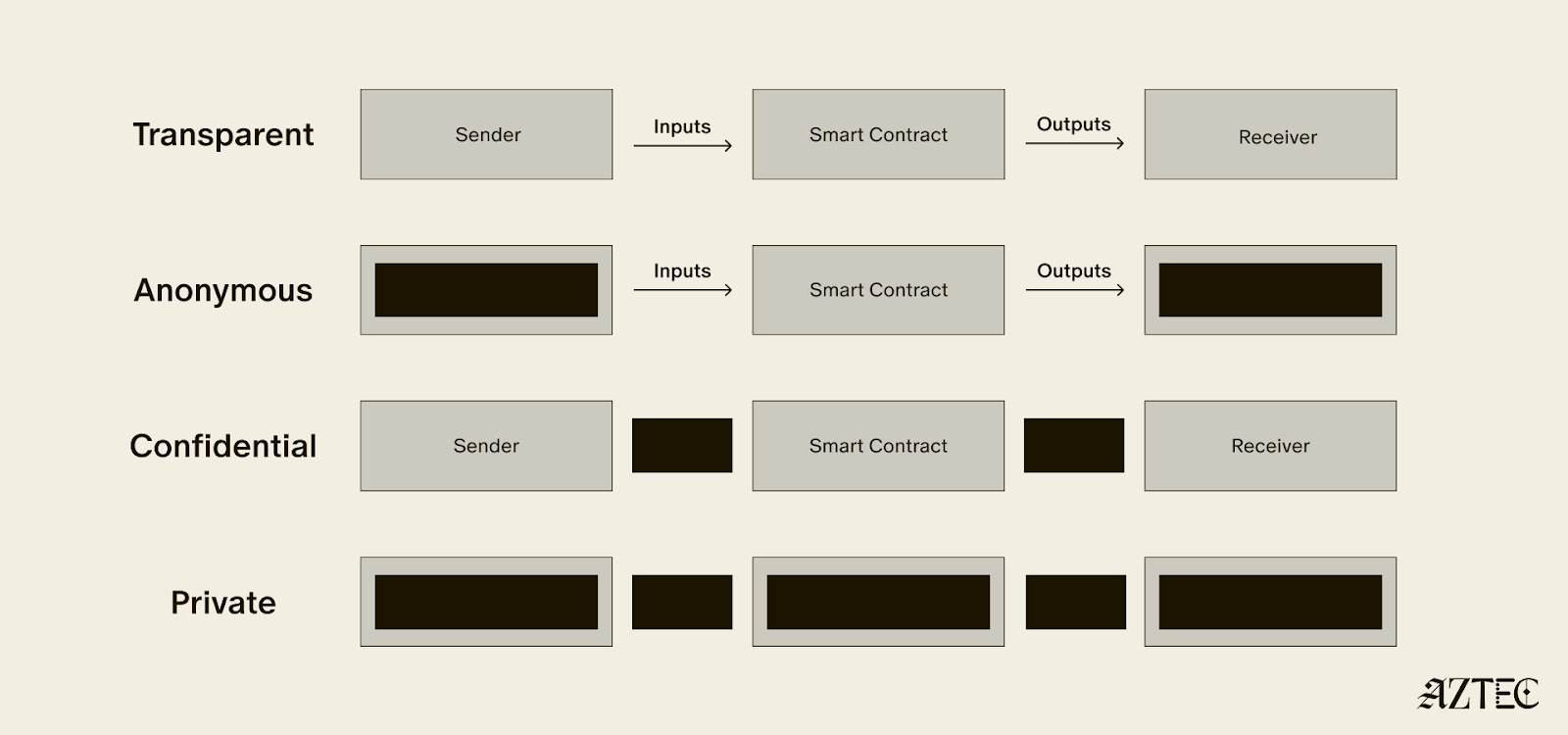
What exactly is a private world computer? A private world computer extends all the functionality of Ethereum with optional privacy at every level, so developers can easily control which aspects they want public or private and users can selectively disclose information. With Aztec, developers can build apps with optional transaction, identity, and compute privacy on a fully decentralized network. Below, we’ll break down the main components of a private world computer.
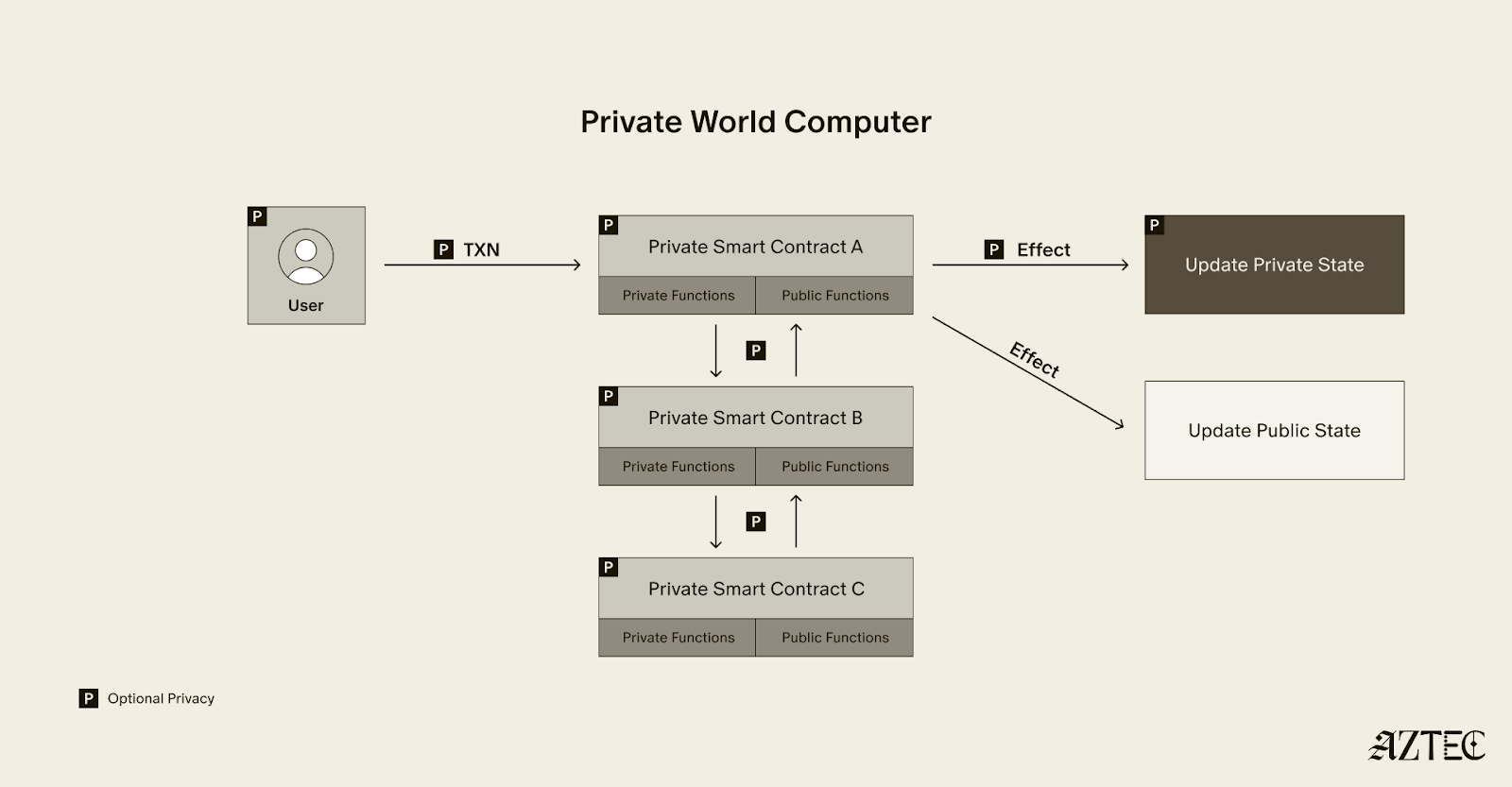
A private world computer is powered by private smart contracts. Private smart contracts have fully optional privacy and also enable seamless public and private function interaction.
Private smart contracts simply extend the functionality of regular smart contracts with added privacy.
As a developer, you can easily designate which functions you want to keep private and which you want to make public. For example, a voting app might allow users to privately cast votes and publicly display the result. Private smart contracts can also interact privately with other smart contracts, without needing to make it public which contracts have interacted.
Transaction: Aztec supports the optionality for fully private inputs, including messages, state, and function calldata. Private state is updated via a private UTXO state tree.
Identity: Using client-side proofs and function execution, Aztec can optionally keep all user info private, including tx.origin and msg.sender for transactions.
Computation: The contract code itself, function execution, and call stack can all be kept private. This includes which contracts you call, what functions in those contracts you’ve called, what the results of those functions were, and what the inputs to the function were.
A decentralized network must be made up of a permissionless network of operators who run the network and decide on upgrades. Aztec is run by a decentralized network of node operators who propose and attest to transactions. Rollup proofs on Aztec are also run by a decentralized prover network that can permissionlessly submit proofs and participate in block rewards. Finally, the Aztec network is governed by the sequencers, who propose, signal, vote, and execute network upgrades.
A private world computer enables the creation of DeFi applications where accounts, transactions, order books, and swaps remain private. Users can protect their trading strategies and positions from public view, preventing front-running and maintaining competitive advantages. Additionally, users can bridge privately into cross-chain DeFi applications, allowing them to participate in DeFi across multiple blockchains while keeping their identity private despite being on an existing transparent blockchain.
This technology makes it possible to bring institutional trading activity on-chain while maintaining the privacy that traditional finance requires. Institutions can privately trade with other institutions globally, without having to touch public markets, enjoying the benefits of blockchain technology such as fast settlement and reduced counterparty risk, without exposing their trading intentions or volumes to the broader market.
Organizations can bring client accounts and assets on-chain while maintaining full compliance. This infrastructure protects on-chain asset trading and settlement strategies, ensuring that sophisticated financial operations remain private. A private world computer also supports private stablecoin issuance and redemption, allowing financial institutions to manage digital currency operations without revealing sensitive business information.
Users have granular control over their privacy settings, allowing them to fine-tune privacy levels for their on-chain identity according to their specific needs. The system enables selective disclosure of on-chain activity, meaning users can choose to reveal certain transactions or holdings to regulators, auditors, or business partners while keeping other information private, meeting compliance requirements.
The shift from transparent blockchains to privacy-preserving infrastructure is the foundation for bringing the next billion users on-chain. Whether you're a developer building the future of private DeFi, an institution exploring compliant on-chain solutions, or simply someone who believes privacy is a fundamental right, now is the time to get involved.
Follow Aztec on X to stay updated on the latest developments in private smart contracts and decentralized privacy technology. Ready to contribute to the network? Run a node and help power the private world computer.
The next Renaissance is here, and it’s being powered by the private world computer.
Special thanks to Santiago Palladino, Phil Windle, Alex Gherghisan, and Mitch Tracy for technical updates and review.
On September 17th, 2025, a new network upgrade was deployed, making Aztec more secure and flexible for home stakers. This upgrade, shipped with all the features needed for a fully decentralized network launch, includes a completely redesigned slashing system that allows inactive or malicious operators to be removed, and does not penalize home stakers for short outages.
With over 23,000 operators running validators across 6 continents (in a variety of conditions), it is critical not to penalize nodes that temporarily drop due to internet connectivity issues. This is because users of the network are also found across the globe, some of whom might have older phones. A significant effort was put into shipping a low-memory proving mode that allows older mobile devices to send transactions and use privacy-preserving apps.
The network was successfully deployed, and all active validators on the old testnet were added to the queue of the new testnet. This manual migration was only necessary because major upgrades to the governance contracts had gone in since the last testnet was deployed. The new testnet started producing blocks after the queue started to be “flushed,” moving validators into the rollup. Because the network is fully decentralized, the initial flush could have been called by anyone. The network produced ~2k blocks before an invalid block made it to the chain and temporarily stalled block production. Block production is now restored and the network is healthy. This post explains what caused the issue and provides an update on the current status of the network.
Note: if you are a network operator, you must upgrade to version 2.0.3 and restart your node to participate in the latest testnet. If you want to run a node, it’s easy to get started.
This upgrade was a team-wide effort that optimized performance and implemented all the mechanisms needed to launch Aztec as a fully decentralized network from day 1.
With these updates in place, we’re ready to test a feature-complete network.
As mentioned above, block production started when someone called the flush function and a minimum number of operators from the queue were let into the validator set.
Shortly thereafter, while testing the network, a member of the Aztec Labs team spun up a “bad” sequencer that produced an invalid block proposal. Specifically, one of the state trees in the proposal was tampered with.

The expectation was that this would be detected immediately and the block rejected. Instead, a bug was discovered in the validator code where the invalid block proposal wasn't checked thoroughly enough. In effect, the proposal got enough attestations, so it was posted to the rollup. Due to extra checks in the nodes, when the nodes pulled the invalid block from Ethereum, they detected the tampered tree and refused to sync it. This is a good outcome as it prevented the attack. Additionally, prover nodes refused to prove the epoch containing the invalid block. This allowed the rollup to prune the entire bad epoch away. After the prune, the invalid state was reset to the last known good block.
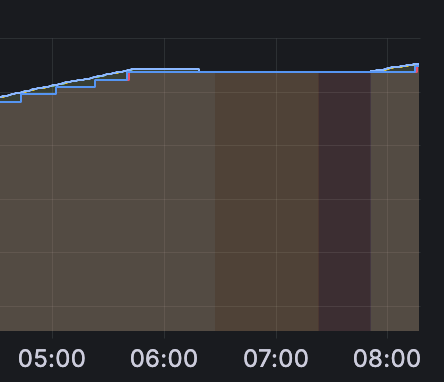
The prune revealed another, smaller bug, where, after a failed block sync, a prune does not get processed correctly, requiring a node restart to clear up. This led to a 90-minute outage from the moment the block proposal was posted until the testnet recovered. The time was equally split between waiting for pruning to happen and for the nodes to restart in order to process the prune.
Validators were correctly re-executing all transactions in the block proposals and verifying that the world state root matched the one in the block proposal, but they failed to check that intermediate tree roots, which are included in the proposal and posted to the rollup contract on L1, were also correct. The attack tweaked one of these intermediate roots while proposing a correct world state root, so it went unnoticed by the attestors.
As mentioned above, even though the block made it through the initial attestation and was posted to L1, the invalid block was caught by the validators, and the entire epoch was never proven as provers refused to generate a proof for the inconsistent state.
A fix was pushed that resolved this issue and ensured that invalid block proposals would be caught and rejected. A second fix was pushed that ensures inconsistent state is removed from the uncommitted cache of the world state.

Block production is currently running smoothly, and the network health has been restored.
Operators who had previously upgraded to version 2.0.3 will need to restart their nodes. Any operator who has not upgraded to 2.0.3 should do so immediately.
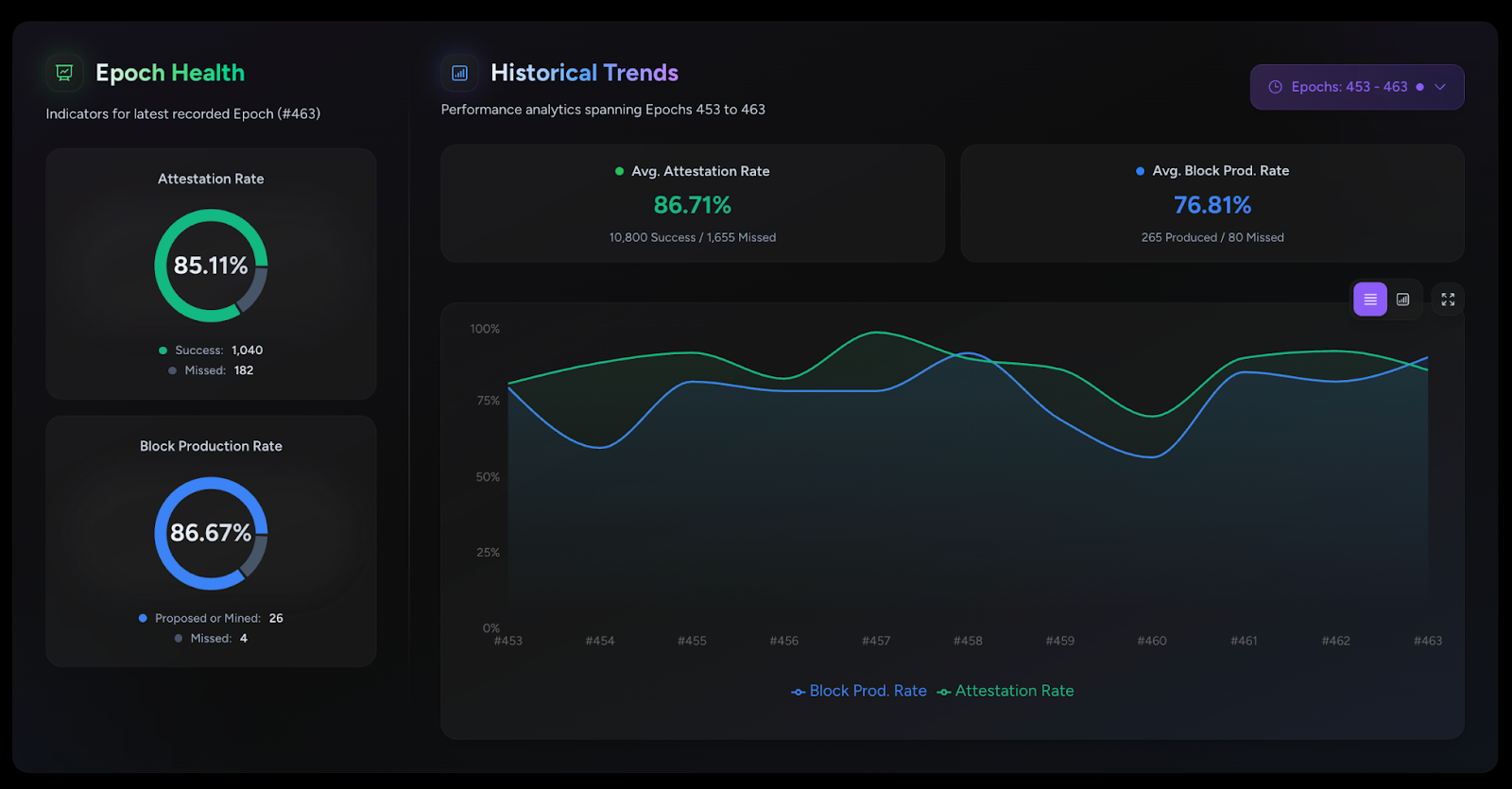
Slashing has also been functioning as expected. Below you can see the slashing signals for each round. A single signal can contain votes for multiple validators, but a validator's attester needs to receive 65 votes to be slashed.
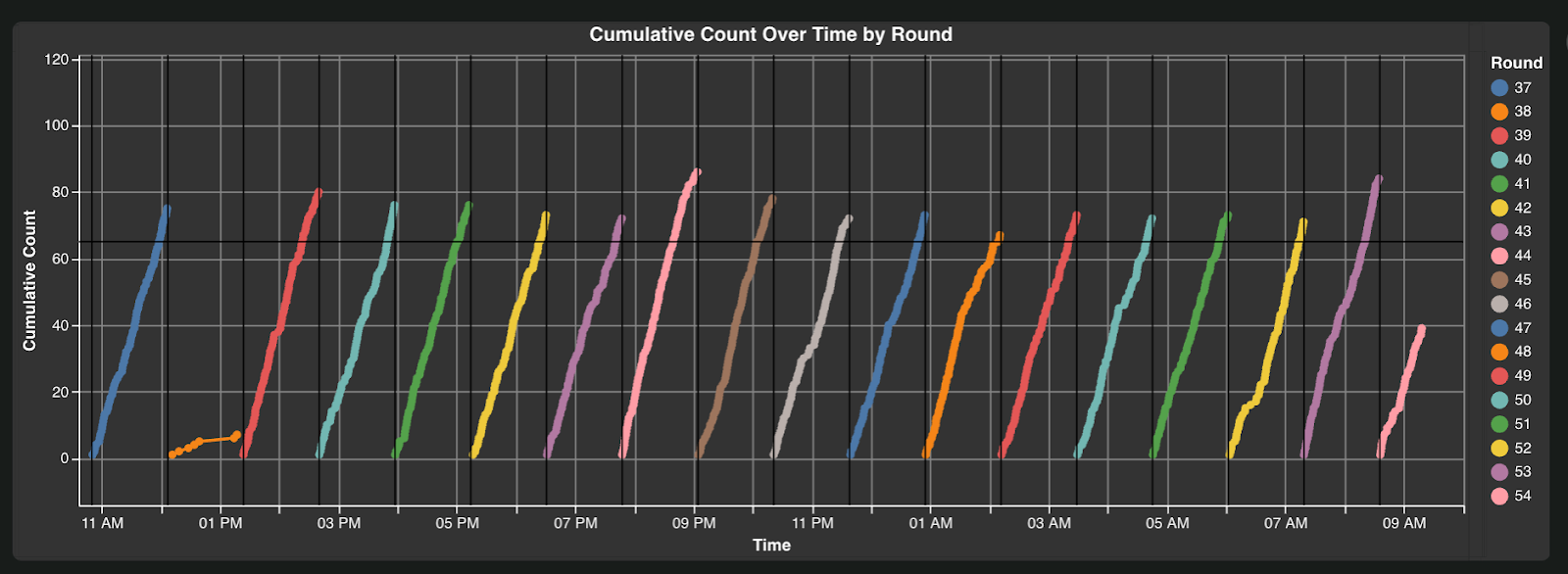
Join us this Thursday, September 25, 2025, at 4 PM CET on the Discord Town Hall to hear more about the 2.0.3 upgrade. To stay up to date with the latest updates for network operators, join the Aztec Discord and follow Aztec on X.
Payy, a privacy-focused payment network, just rewrote its entire ZK architecture from Halo2 to Noir while keeping its network live, funds safe, and users happy.
Code that took months to write now takes weeks (with MVPs built in as little as 30 minutes). Payy’s codebase shrank from thousands of lines to 250, and now their entire engineering team can actually work on its privacy infra.
This is the story of how they transformed their ZK ecosystem from one bottlenecked by a single developer to a system their entire team can modify and maintain.

Eighteen months ago, Payy faced a deceptively simple requirement: build a privacy-preserving payment network that actually works on phones. That requires client-side proving.
"Anyone who tells you they can give you privacy without the proof being on the phone is lying to you," Calum Moore - Payy's Technical Lead - states bluntly.
To make a private, mobile network work, they needed:
To start, the team evaluated available ZK stacks through their zkbench framework:
STARKs (e.g., RISC Zero): Memory requirements made them a non-starter on mobile. Large proof sizes are unsuitable for mobile data transmission.
Circom with Groth16: Required trusted setup ceremonies for each circuit update. It had “abstracted a bit too early” and, as a result, is not high-level enough to develop comfortably, but not low-level enough for controls and optimizations, said Calum.
Halo2: Selected based on existing production deployments (ZCash, Scroll), small proof sizes, and an existing Ethereum verifier. As Calum admitted with the wisdom of hindsight: “Back a year and a half ago, there weren’t any other real options.”
Halo2 delivered on its promises: Payy successfully launched its network. But cracks started showing almost immediately.
First, they had to write their own chips from scratch. Then came the real fun: if statements.
"With Halo2, I'm building a chip, I'm passing this chip in... It's basically a container chip, so you'd set the value to zero or one depending on which way you want it to go. And, you'd zero out the previous value if you didn't want it to make a difference to the calculation," Calum explained, “when I’m writing in Noir, I just write ‘if’. "
With Halo2, writing an if statement (programming 101) required building custom chip infra.
Binary decomposition, another fundamental operation for rollups, meant more custom chips. The Halo2 implementation quickly grew to thousands of lines of incomprehensible code.
And only Calum could touch any of it.
The Bottleneck
"It became this black box that no one could touch, no one could reason about, no one could verify," he recalls. "Obviously, we had it audited, and we were confident in that. But any changes could only be done by me, could only be verified by me or an auditor."
In engineering terms, this is called a bus factor of one: if Calum got hit by a bus (or took a vacation to Argentina), Payy's entire proving system would be frozen. "Those circuits are open source," Calum notes wryly, "but who's gonna be able to read the Halo2 circuits? Nobody."
During a launch event in Argentina, "I was like, oh, I'll check out Noir again. See how it's going," Calum remembers. He'd been tracking Noir's progress for months, occasionally testing it out, waiting for it to be reliable.
"I wrote basically our entire client-side proof in about half an hour in Noir. And it probably took me - I don't know, three weeks to write that proof originally in Halo2."
Calum recreated Payy's client-side proof in Noir in 30 minutes. And when he tested the proving speed, without any optimization, they were seeing 2x speed improvements.
"I kind of internally… didn't want to tell my cofounder Sid that I'd already made my decision to move to Noir," Calum admits. "I hadn't broken it to him yet because it's hard to justify rewriting your proof system when you have a deployed network with a bunch of money already on the network and a bunch of users."
Convincing a team to rewrite the core of a live financial network takes some evidence. The technical evaluation of Noir revealed improvements across every metric:
Proof Generation Time: Sub-0.5 second proof generation on iPhones. "We're obsessive about performance," Calum notes (they’re confident they can push it even further).
Code Complexity: Their entire ZK implementation compressed from thousands of lines of Halo2 to just 250 lines of Noir code. "With rollups, the logic isn't complex—it's more about the preciseness of the logic," Calum explains.
Composability: In Halo2, proof aggregation required hardwiring specific verifiers for each proof type. Noir offers a general-purpose verifier that accepts any proof of consistent size.
"We can have 100 different proving systems, which are hyper-efficient for the kind of application that we're doing," Calum explains. "Have them all aggregated by the same aggregation proof, and reason about whatever needs to be."
Initially, the goal was to "completely mirror our Halo2 proofs": no new features. This conservative approach meant they could verify correctness while maintaining a live network.
The migration preserved Payy's production architecture:
"If you have your proofs in Noir, any person who understands even a little bit about logic or computers can go in and say, 'okay, I can kinda see what's happening here'," Calum notes.
The audit process completely transformed. With Halo2: "The auditors that are available to audit Halo2 are few and far between."
With Noir: "You could have an auditor that had no Noir experience do at least a 95% job."
Why? Most audit issues are logic errors, not ZK-specific bugs. When auditors can read your code, they find real problems instead of getting lost in implementation details.
Halo2: Binary decomposition
Payy’s previous 383 line implementation of binary decomposition can be viewed here (pkg/zk-circuits/src/chips/binary_decomposition.rs).
Payy’s previous binary decomposition implementation
Meanwhile, binary decomposition is handled in Noir with the following single line.
pub fn to_le_bits<let N: u32>(self: Self) -> [u1; N]
(Source)
With Noir's composable proof system, Payy can now build specialized provers for different operations, each optimized for its specific task.
"If statements are horrendous in SNARKs because you pay the cost of the if statement regardless of its run," Calum explains. But with Noir's approach, "you can split your application logic into separate proofs, and run whichever proof is for the specific application you're looking for."
Instead of one monolithic proof trying to handle every case, you can have specialized proofs, each perfect for its purpose.
"I fell a little bit in love with Halo2," Calum admits, "maybe it's Stockholm syndrome where you're like, you know, it's a love-hate relationship, and it's really hard. But at the same time, when you get a breakthrough with it, you're like, yes, I feel really good because I'm basically writing assembly-level ZK proofs."
“But now? I just write ‘if’.”
Technical Note: While "migrating from Halo2 to Noir" is shorthand that works for this article, technically Halo2 is an integrated proving system where circuits must be written directly in Rust using its constraint APIs, while Noir is a high-level language that compiles to an intermediate representation and can use various proving backends. Payy specifically moved from writing circuits in Halo2's low-level constraint system to writing them in Noir's high-level language, with Barretenberg (UltraHonk) as their proving backend.
Both tools ultimately enable developers to write circuits and generate proofs, but Noir's modular architecture separates circuit logic from the proving system - which is what made Payy's circuits so much more accessible to their entire team, and now allows them to swap out their proving system with minimal effort as proving systems improve.
Payy's code is open source and available for developers looking to learn from their implementation.
After eight years of solving impossible problems, the next renaissance is here.
We’re at a major inflection point, with both our tech and our builder community going through growth spurts. The purpose of this rebrand is simple: to draw attention to our full-stack privacy-native network and to elevate the rich community of builders who are creating a thriving ecosystem around it.
For eight years, we’ve been obsessed with solving impossible challenges. We invented new cryptography (Plonk), created an intuitive programming language (Noir), and built the first decentralized network on Ethereum where privacy is native rather than an afterthought.
It wasn't easy. But now, we're finally bringing that powerful network to life. Testnet is live with thousands of active users and projects that were technically impossible before Aztec.
Our community evolution mirrors our technical progress. What started as an intentionally small, highly engaged group of cracked developers is now welcoming waves of developers eager to build applications that mainstream users actually want and need.
A brand is more than aesthetics—it's a mental model that makes Aztec's spirit tangible.
Renaissance means "rebirth"—and that's exactly what happens when developers gain access to privacy-first infrastructure. We're witnessing the emergence of entirely new application categories, business models, and user experiences.
The faces of this renaissance are the builders we serve: the entrepreneurs building privacy-preserving DeFi, the activists building identity systems that protect user privacy, the enterprise architects tokenizing real-world assets, and the game developers creating experiences with hidden information.
This next renaissance isn't just about technology—it's about the ethos behind the build. These aren't just our values. They're the shared DNA of every builder pushing the boundaries of what's possible on Aztec.
Agency: It’s what everyone deserves, and very few truly have: the ability to choose and take action for ourselves. On the Aztec Network, agency is native
Genius: That rare cocktail of existential thirst, extraordinary brilliance, and mind-bending creation. It’s fire that fuels our great leaps forward.
Integrity: It’s the respect and compassion we show each other. Our commitment to attacking the hardest problems first, and the excellence we demand of any solution.
Obsession: That highly concentrated insanity, extreme doggedness, and insatiable devotion that makes us tick. We believe in a different future—and we can make it happen, together.
Just as our technology bridges different eras of cryptographic innovation, our new visual identity draws from multiple periods of human creativity and technological advancement.
Our new wordmark embodies the diversity of our community and the permissionless nature of our network. Each letter was custom-drawn to reflect different pivotal moments in human communication and technological progress.
Together, these letters tell the story of human innovation: each era building on the last, each breakthrough enabling the next renaissance. And now, we're building the infrastructure for the one that's coming.
We evolved our original icon to reflect this new chapter while honoring our foundation. The layered diamond structure tells the story:
The architecture echoes a central plaza—the Roman forum, the Greek agora, the English commons, the American town square—places where people gather, exchange ideas, build relationships, and shape culture. It's a fitting symbol for the infrastructure enabling the next leap in human coordination and creativity.
From the Mughal and Edo periods to the Flemish and Italian Renaissance, our brand imagery draws from different cultures and eras of extraordinary human flourishing—periods when science, commerce, culture and technology converged to create unprecedented leaps forward. These visuals reflect both the universal nature of the Renaissance and the global reach of our network.
But we're not just celebrating the past —we're creating the future: the infrastructure for humanity's next great creative and technological awakening, powered by privacy-native blockchain technology.
Join us to ask questions, learn more and dive into the lore.
Join Our Discord Town Hall. September 4th at 8 AM PT, then every Thursday at 7 AM PT. Come hear directly from our team, ask questions, and connect with other builders who are shaping the future of privacy-first applications.
Take your stance on privacy. Visit the privacy glyph generator to create your custom profile pic and build this new world with us.
Stay Connected. Visit the new website and to stay up-to-date on all things Noir and Aztec, make sure you’re following along on X.
The next renaissance is what you build on Aztec—and we can't wait to see what you'll create.
Aztec’s Public Testnet launched in May 2025.
Since then, we’ve been obsessively working toward our ultimate goal: launching the first fully decentralized privacy-preserving layer-2 (L2) network on Ethereum. This effort has involved a team of over 70 people, including world-renowned cryptographers and builders, with extensive collaboration from the Aztec community.
To make something private is one thing, but to also make it decentralized is another. Privacy is only half of the story. Every component of the Aztec Network will be decentralized from day one because decentralization is the foundation that allows privacy to be enforced by code, not by trust. This includes sequencers, which order and validate transactions, provers, which create privacy-preserving cryptographic proofs, and settlement on Ethereum, which finalizes transactions on the secure Ethereum mainnet to ensure trust and immutability.
Strong progress is being made by the community toward full decentralization. The Aztec Network now includes nearly 1,000 sequencers in its validator set, with 15,000 nodes spread across more than 50 countries on six continents. With this globally distributed network in place, the Aztec Network is ready for users to stress test and challenge its resilience.
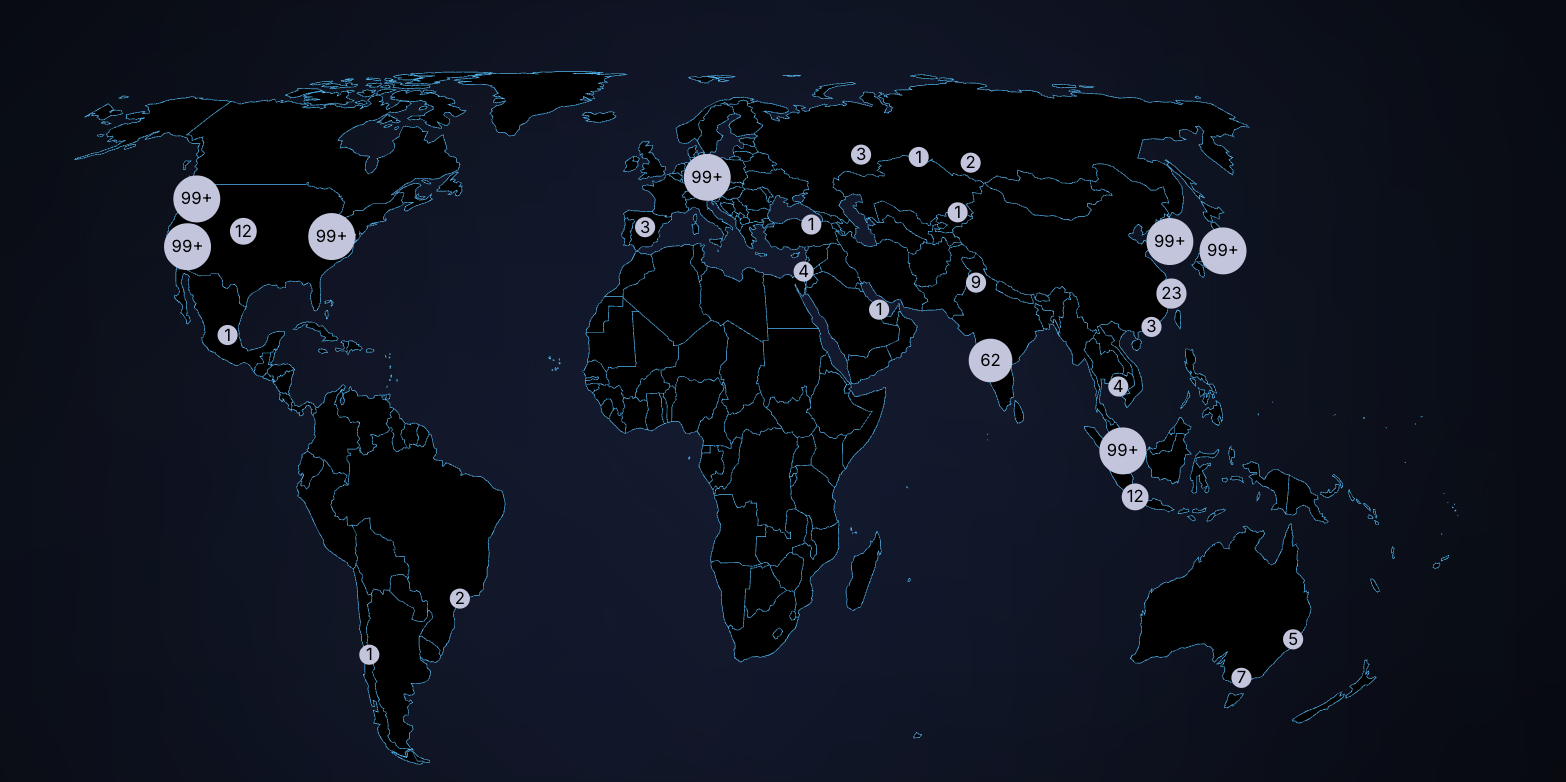
We're now entering a new phase: the Adversarial Testnet. This stage will test the resilience of the Aztec Testnet and its decentralization mechanisms.
The Adversarial Testnet introduces two key features: slashing, which penalizes validators for malicious or negligent behavior in Proof-of-Stake (PoS) networks, and a fully decentralized governance mechanism for protocol upgrades.
This phase will also simulate network attacks to test its ability to recover independently, ensuring it could continue to operate even if the core team and servers disappeared (see more on Vitalik’s “walkaway test” here). It also opens the validator set to more people using ZKPassport, a private identity verification app, to verify their identity online.
The Aztec Network testnet is decentralized, run by a permissionless network of sequencers.
The slashing upgrade tests one of the most fundamental mechanisms for removing inactive or malicious sequencers from the validator set, an essential step toward strengthening decentralization.
Similar to Ethereum, on the Aztec Network, any inactive or malicious sequencers will be slashed and removed from the validator set. Sequencers will be able to slash any validator that makes no attestations for an entire epoch or proposes an invalid block.
Three slashes will result in being removed from the validator set. Sequencers may rejoin the validator set at any time after getting slashed; they just need to rejoin the queue.
In addition to testing network resilience when validators go offline and evaluating the slashing mechanisms, the Adversarial Testnet will also assess the robustness of the network’s decentralized governance during protocol upgrades.
Adversarial Testnet introduces changes to Aztec Network’s governance system.
Sequencers now have an even more central role, as they are the sole actors permitted to deposit assets into the Governance contract.
After the upgrade is defined and the proposed contracts are deployed, sequencers will vote on and implement the upgrade independently, without any involvement from Aztec Labs and/or the Aztec Foundation.
Starting today, you can join the Adversarial Testnet to help battle-test Aztec’s decentralization and security. Anyone can compete in six categories for a chance to win exclusive Aztec swag, be featured on the Aztec X account, and earn a DappNode. The six challenge categories include:
Performance will be tracked using Dashtec, a community-built dashboard that pulls data from publicly available sources. Dashtec displays a weighted score of your validator performance, which may be used to evaluate challenges and award prizes.
The dashboard offers detailed insights into sequencer performance through a stunning UI, allowing users to see exactly who is in the current validator set and providing a block-by-block view of every action taken by sequencers.
To join the validator set and start tracking your performance, click here. Join us on Thursday, July 31, 2025, at 4 pm CET on Discord for a Town Hall to hear more about the challenges and prizes. Who knows, we might even drop some alpha.
To stay up-to-date on all things Noir and Aztec, make sure you’re following along on X.
Privacy has emerged as a major driver for the crypto industry in 2025. We’ve seen the explosion of Zcash, the Ethereum Foundation’s refocusing of PSE, and the launch of Aztec’s testnet with over 24,000 validators powering the network. Many apps have also emerged to bring private transactions to Ethereum and Solana in various ways, and exciting technologies like ZKPassport that privately bring identity on-chain using Noir have become some of the most talked about developments for ushering in the next big movements to the space.
Underpinning all of these developments is the emerging consensus that without privacy, blockchains will struggle to gain real-world adoption.
Without privacy, institutions can’t bring assets on-chain in a compliant way or conduct complex swaps and trades without revealing their strategies. Without privacy, DeFi remains dominated and controlled by advanced traders who can see all upcoming transactions and manipulate the market. Without privacy, regular people will not want to move their lives on-chain for the entire world to see every detail about their every move.
While there's been lots of talk about privacy, few can define it. In this piece we’ll outline the three pillars of privacy and gives you a framework for evaluating the privacy claims of any project.
True privacy rests on three essential pillars: transaction privacy, identity privacy, and computational privacy. It is only when we have all three pillars that we see the emergence of a private world computer.

Transaction privacy means that both inputs and outputs are not viewable by anyone other than the intended participants. Inputs include any asset, value, message, or function calldata that is being sent. Outputs include any state changes or transaction effects, or any transaction metadata caused by the transaction. Transaction privacy is often primarily achieved using a UTXO model (like Zcash or Aztec’s private state tree). If a project has only the option for this pillar, it can be said to be confidential, but not private.
Identity privacy means that the identities of those involved are not viewable by anyone other than the intended participants. This includes addresses or accounts and any information about the identity of the participants, such as tx.origin, msg.sender, or linking one’s private account to public accounts. Identity privacy can be achieved in several ways, including client-side proof generation that keeps all user info on the users’ devices. If a project has only the option for this pillar, it can be said to be anonymous, but not private.
Computation privacy means that any activity that happens is not viewable by anyone other than the intended participants. This includes the contract code itself, function execution, contract address, and full callstack privacy. Additionally, any metadata generated by the transaction is able to be appropriately obfuscated (such as transaction effects, events are appropriately padded, inclusion block number are in appropriate sets). Callstack privacy includes which contracts you call, what functions in those contracts you’ve called, what the results of those functions were, any subsequent functions that will be called after, and what the inputs to the function were. A project must have the option for this pillar to do anything privately other than basic transactions.
Bitcoin ushered in a new paradigm of digital money. As a permissionless, peer-to-peer currency and store of value, it changed the way value could be sent around the world and who could participate. Ethereum expanded this vision to bring us the world computer, a decentralized, general-purpose blockchain with programmable smart contracts.

Given the limitations of running a transparent blockchain that exposes all user activity, accounts, and assets, it was clear that adding the option to preserve privacy would unlock many benefits (and more closely resemble real cash). But this was a very challenging problem. Zcash was one of the first to extend Bitcoin’s functionality with optional privacy, unlocking a new privacy-preserving UTXO model for transacting privately. As we’ll see below, many of the current privacy-focused projects are working on similar kinds of private digital money for Ethereum or other chains.
Now, Aztec is bringing us the final missing piece: a private world computer.
A private world computer is fully decentralized, programmable, and permissionless like Ethereum and has optional privacy at every level. In other words, Aztec is extending all the functionality of Ethereum with optional transaction, identity, and computational privacy. This is the only approach that enables fully compliant, decentralized applications to be built that preserve user privacy, a new design space that we see as ushering in the next Renaissance for the space.
Private digital money emerges when you have the first two privacy pillars covered - transactions and identity - but you don’t have the third - computation. Almost all projects today that claim some level of privacy are working on private digital money. This includes everything from privacy pools on Ethereum and L2s to newly emerging payment L1s like Tempo and Arc that are developing various degrees of transaction privacy
When it comes to digital money, privacy exists on a spectrum. If your identity is hidden but your transactions are visible, that's what we call anonymous. If your transactions are hidden but your identity is known, that's confidential. And when both your identity and transactions are protected, that's true privacy. Projects are working on many different approaches to implement this, from PSE to Payy using Noir, the zkDSL built to make it intuitive to build zk applications using familiar Rust-like syntax.

Private digital money is designed to make payments private, but any interaction with more complex smart contracts than a straightforward payment transaction is fully exposed.
What if we also want to build decentralized private apps using smart contracts (usually multiple that talk to each other)? For this, you need all three privacy pillars: transaction, identity, and compute.
If you have these three pillars covered and you have decentralization, you have built a private world computer. Without decentralization, you are vulnerable to censorship, privileged backdoors and inevitable centralized control that can compromise privacy guarantees.

What exactly is a private world computer? A private world computer extends all the functionality of Ethereum with optional privacy at every level, so developers can easily control which aspects they want public or private and users can selectively disclose information. With Aztec, developers can build apps with optional transaction, identity, and compute privacy on a fully decentralized network. Below, we’ll break down the main components of a private world computer.

A private world computer is powered by private smart contracts. Private smart contracts have fully optional privacy and also enable seamless public and private function interaction.
Private smart contracts simply extend the functionality of regular smart contracts with added privacy.
As a developer, you can easily designate which functions you want to keep private and which you want to make public. For example, a voting app might allow users to privately cast votes and publicly display the result. Private smart contracts can also interact privately with other smart contracts, without needing to make it public which contracts have interacted.
Transaction: Aztec supports the optionality for fully private inputs, including messages, state, and function calldata. Private state is updated via a private UTXO state tree.
Identity: Using client-side proofs and function execution, Aztec can optionally keep all user info private, including tx.origin and msg.sender for transactions.
Computation: The contract code itself, function execution, and call stack can all be kept private. This includes which contracts you call, what functions in those contracts you’ve called, what the results of those functions were, and what the inputs to the function were.
A decentralized network must be made up of a permissionless network of operators who run the network and decide on upgrades. Aztec is run by a decentralized network of node operators who propose and attest to transactions. Rollup proofs on Aztec are also run by a decentralized prover network that can permissionlessly submit proofs and participate in block rewards. Finally, the Aztec network is governed by the sequencers, who propose, signal, vote, and execute network upgrades.
A private world computer enables the creation of DeFi applications where accounts, transactions, order books, and swaps remain private. Users can protect their trading strategies and positions from public view, preventing front-running and maintaining competitive advantages. Additionally, users can bridge privately into cross-chain DeFi applications, allowing them to participate in DeFi across multiple blockchains while keeping their identity private despite being on an existing transparent blockchain.
This technology makes it possible to bring institutional trading activity on-chain while maintaining the privacy that traditional finance requires. Institutions can privately trade with other institutions globally, without having to touch public markets, enjoying the benefits of blockchain technology such as fast settlement and reduced counterparty risk, without exposing their trading intentions or volumes to the broader market.
Organizations can bring client accounts and assets on-chain while maintaining full compliance. This infrastructure protects on-chain asset trading and settlement strategies, ensuring that sophisticated financial operations remain private. A private world computer also supports private stablecoin issuance and redemption, allowing financial institutions to manage digital currency operations without revealing sensitive business information.
Users have granular control over their privacy settings, allowing them to fine-tune privacy levels for their on-chain identity according to their specific needs. The system enables selective disclosure of on-chain activity, meaning users can choose to reveal certain transactions or holdings to regulators, auditors, or business partners while keeping other information private, meeting compliance requirements.
The shift from transparent blockchains to privacy-preserving infrastructure is the foundation for bringing the next billion users on-chain. Whether you're a developer building the future of private DeFi, an institution exploring compliant on-chain solutions, or simply someone who believes privacy is a fundamental right, now is the time to get involved.
Follow Aztec on X to stay updated on the latest developments in private smart contracts and decentralized privacy technology. Ready to contribute to the network? Run a node and help power the private world computer.
The next Renaissance is here, and it’s being powered by the private world computer.
After eight years of solving impossible problems, the next renaissance is here.
We’re at a major inflection point, with both our tech and our builder community going through growth spurts. The purpose of this rebrand is simple: to draw attention to our full-stack privacy-native network and to elevate the rich community of builders who are creating a thriving ecosystem around it.
For eight years, we’ve been obsessed with solving impossible challenges. We invented new cryptography (Plonk), created an intuitive programming language (Noir), and built the first decentralized network on Ethereum where privacy is native rather than an afterthought.
It wasn't easy. But now, we're finally bringing that powerful network to life. Testnet is live with thousands of active users and projects that were technically impossible before Aztec.
Our community evolution mirrors our technical progress. What started as an intentionally small, highly engaged group of cracked developers is now welcoming waves of developers eager to build applications that mainstream users actually want and need.
A brand is more than aesthetics—it's a mental model that makes Aztec's spirit tangible.
Renaissance means "rebirth"—and that's exactly what happens when developers gain access to privacy-first infrastructure. We're witnessing the emergence of entirely new application categories, business models, and user experiences.
The faces of this renaissance are the builders we serve: the entrepreneurs building privacy-preserving DeFi, the activists building identity systems that protect user privacy, the enterprise architects tokenizing real-world assets, and the game developers creating experiences with hidden information.
This next renaissance isn't just about technology—it's about the ethos behind the build. These aren't just our values. They're the shared DNA of every builder pushing the boundaries of what's possible on Aztec.
Agency: It’s what everyone deserves, and very few truly have: the ability to choose and take action for ourselves. On the Aztec Network, agency is native
Genius: That rare cocktail of existential thirst, extraordinary brilliance, and mind-bending creation. It’s fire that fuels our great leaps forward.
Integrity: It’s the respect and compassion we show each other. Our commitment to attacking the hardest problems first, and the excellence we demand of any solution.
Obsession: That highly concentrated insanity, extreme doggedness, and insatiable devotion that makes us tick. We believe in a different future—and we can make it happen, together.
Just as our technology bridges different eras of cryptographic innovation, our new visual identity draws from multiple periods of human creativity and technological advancement.
Our new wordmark embodies the diversity of our community and the permissionless nature of our network. Each letter was custom-drawn to reflect different pivotal moments in human communication and technological progress.
Together, these letters tell the story of human innovation: each era building on the last, each breakthrough enabling the next renaissance. And now, we're building the infrastructure for the one that's coming.
We evolved our original icon to reflect this new chapter while honoring our foundation. The layered diamond structure tells the story:
The architecture echoes a central plaza—the Roman forum, the Greek agora, the English commons, the American town square—places where people gather, exchange ideas, build relationships, and shape culture. It's a fitting symbol for the infrastructure enabling the next leap in human coordination and creativity.
From the Mughal and Edo periods to the Flemish and Italian Renaissance, our brand imagery draws from different cultures and eras of extraordinary human flourishing—periods when science, commerce, culture and technology converged to create unprecedented leaps forward. These visuals reflect both the universal nature of the Renaissance and the global reach of our network.
But we're not just celebrating the past —we're creating the future: the infrastructure for humanity's next great creative and technological awakening, powered by privacy-native blockchain technology.
Join us to ask questions, learn more and dive into the lore.
Join Our Discord Town Hall. September 4th at 8 AM PT, then every Thursday at 7 AM PT. Come hear directly from our team, ask questions, and connect with other builders who are shaping the future of privacy-first applications.
Take your stance on privacy. Visit the privacy glyph generator to create your custom profile pic and build this new world with us.
Stay Connected. Visit the new website and to stay up-to-date on all things Noir and Aztec, make sure you’re following along on X.
The next renaissance is what you build on Aztec—and we can't wait to see what you'll create.
Aztec’s Public Testnet launched in May 2025.
Since then, we’ve been obsessively working toward our ultimate goal: launching the first fully decentralized privacy-preserving layer-2 (L2) network on Ethereum. This effort has involved a team of over 70 people, including world-renowned cryptographers and builders, with extensive collaboration from the Aztec community.
To make something private is one thing, but to also make it decentralized is another. Privacy is only half of the story. Every component of the Aztec Network will be decentralized from day one because decentralization is the foundation that allows privacy to be enforced by code, not by trust. This includes sequencers, which order and validate transactions, provers, which create privacy-preserving cryptographic proofs, and settlement on Ethereum, which finalizes transactions on the secure Ethereum mainnet to ensure trust and immutability.
Strong progress is being made by the community toward full decentralization. The Aztec Network now includes nearly 1,000 sequencers in its validator set, with 15,000 nodes spread across more than 50 countries on six continents. With this globally distributed network in place, the Aztec Network is ready for users to stress test and challenge its resilience.

We're now entering a new phase: the Adversarial Testnet. This stage will test the resilience of the Aztec Testnet and its decentralization mechanisms.
The Adversarial Testnet introduces two key features: slashing, which penalizes validators for malicious or negligent behavior in Proof-of-Stake (PoS) networks, and a fully decentralized governance mechanism for protocol upgrades.
This phase will also simulate network attacks to test its ability to recover independently, ensuring it could continue to operate even if the core team and servers disappeared (see more on Vitalik’s “walkaway test” here). It also opens the validator set to more people using ZKPassport, a private identity verification app, to verify their identity online.
The Aztec Network testnet is decentralized, run by a permissionless network of sequencers.
The slashing upgrade tests one of the most fundamental mechanisms for removing inactive or malicious sequencers from the validator set, an essential step toward strengthening decentralization.
Similar to Ethereum, on the Aztec Network, any inactive or malicious sequencers will be slashed and removed from the validator set. Sequencers will be able to slash any validator that makes no attestations for an entire epoch or proposes an invalid block.
Three slashes will result in being removed from the validator set. Sequencers may rejoin the validator set at any time after getting slashed; they just need to rejoin the queue.
In addition to testing network resilience when validators go offline and evaluating the slashing mechanisms, the Adversarial Testnet will also assess the robustness of the network’s decentralized governance during protocol upgrades.
Adversarial Testnet introduces changes to Aztec Network’s governance system.
Sequencers now have an even more central role, as they are the sole actors permitted to deposit assets into the Governance contract.
After the upgrade is defined and the proposed contracts are deployed, sequencers will vote on and implement the upgrade independently, without any involvement from Aztec Labs and/or the Aztec Foundation.
Starting today, you can join the Adversarial Testnet to help battle-test Aztec’s decentralization and security. Anyone can compete in six categories for a chance to win exclusive Aztec swag, be featured on the Aztec X account, and earn a DappNode. The six challenge categories include:
Performance will be tracked using Dashtec, a community-built dashboard that pulls data from publicly available sources. Dashtec displays a weighted score of your validator performance, which may be used to evaluate challenges and award prizes.
The dashboard offers detailed insights into sequencer performance through a stunning UI, allowing users to see exactly who is in the current validator set and providing a block-by-block view of every action taken by sequencers.
To join the validator set and start tracking your performance, click here. Join us on Thursday, July 31, 2025, at 4 pm CET on Discord for a Town Hall to hear more about the challenges and prizes. Who knows, we might even drop some alpha.
To stay up-to-date on all things Noir and Aztec, make sure you’re following along on X.
On May 1st, 2025, Aztec Public Testnet went live.
Within the first 24 hours, over 20k users visited the Aztec Playground and started to send transactions on testnet. Additionally, 10 apps launched live on the testnet, including wallets, block explorers, and private DeFi and NFT marketplaces. Launching a decentralized testnet poses significant challenges, and we’re proud that the network has continued to run despite high levels of congestion that led to slow block production for a period of time.
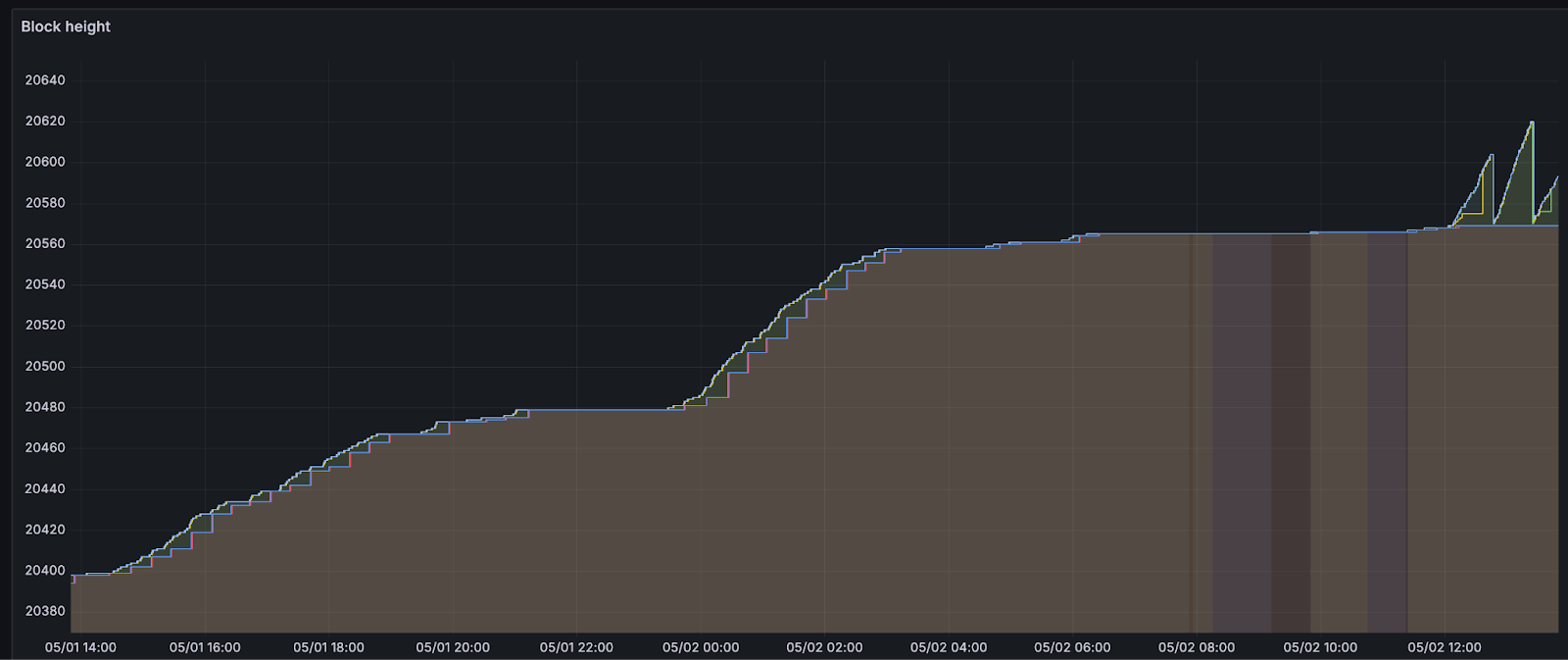
Around 6 hours after announcing the network launch, more than 150 sequencers had joined the validator set to sequence transactions and propose blocks for the network. 500+ additional full nodes were spun up by node operators participating in our Discord community. These sequencers were flooded with over 5k transactions before block production slowed. Let’s dive into why block production slowed down.
On Aztec, an epoch is a group of 32 blocks that are rolled up for settlement on Ethereum. Leading up to the slowdown of block production, there were entire epochs with full blocks (8 transactions, or 0.2TPS) in every slot. The sequencers were building blocks and absorbing the demand for blockspace from users of the Aztec playground, and there was a build up of 100s of pending transactions in sequencer mempools.
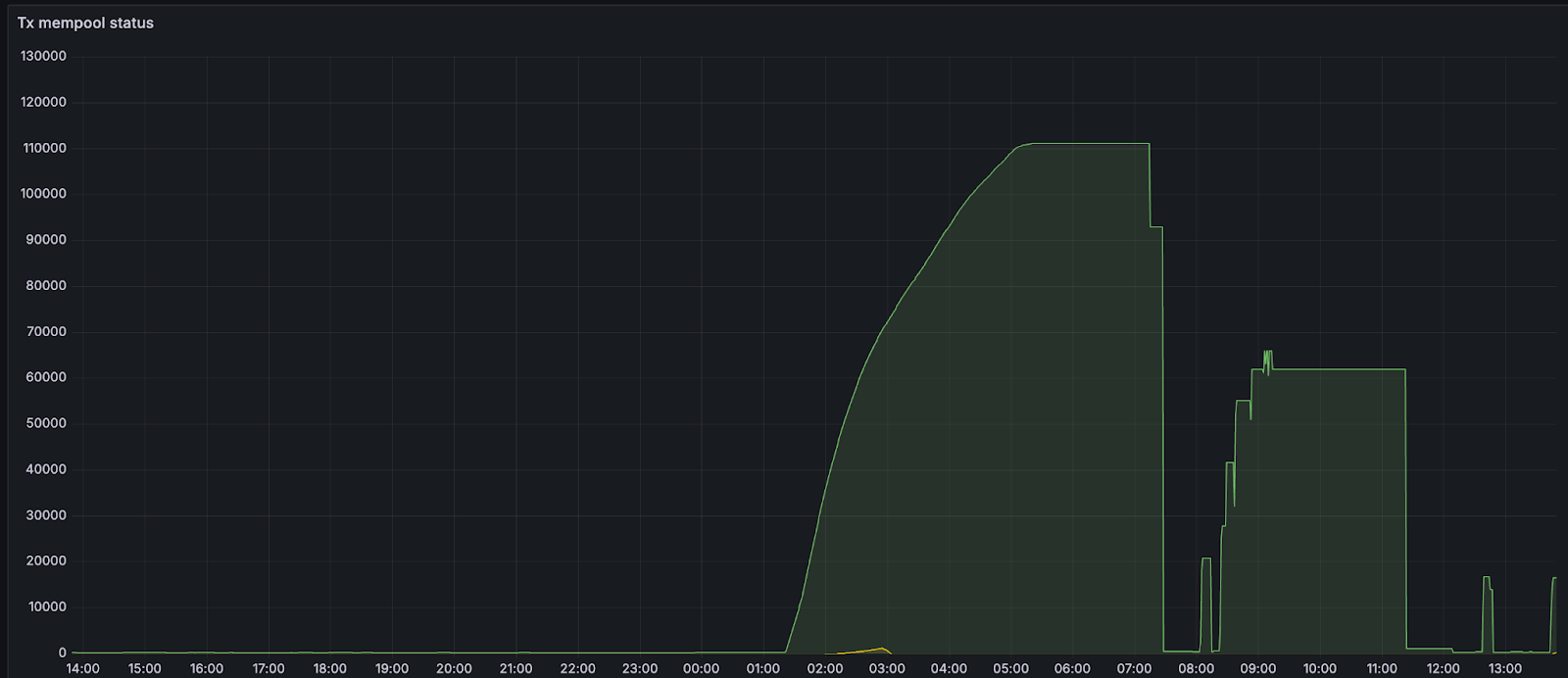
Issues arose when these transactions started to exceed the mempool size, which was configured to hold only 100mb or about 700 transactions.
As many new validators were brought through the funnel and started to come online, the mempools of existing validators (already full at 700 transactions) and new ones (at 0 transactions) diverged significantly. When earlier validators proposed blocks, newer validators didn't have the transactions and could not attest to blocks because the request/response protocol wasn't aggressive enough. When newer validators made proposals, earlier validators didn't have transactions (their mempools were full), so they could not attest to blocks.
New validators then started to build up pending transactions. When validators with full mempools requested missing transactions from peers, they would evict existing transactions from their mempools (mempool is at max memory) based on priority fee. All transactions had default fee settings, so validators were randomly ejecting transactions and were not doing so in lockstep (different validators ejected different transactions). For a little over an hour, the mempools diverged significantly from each other, and block production slowed down to about 20% of the expected rate.
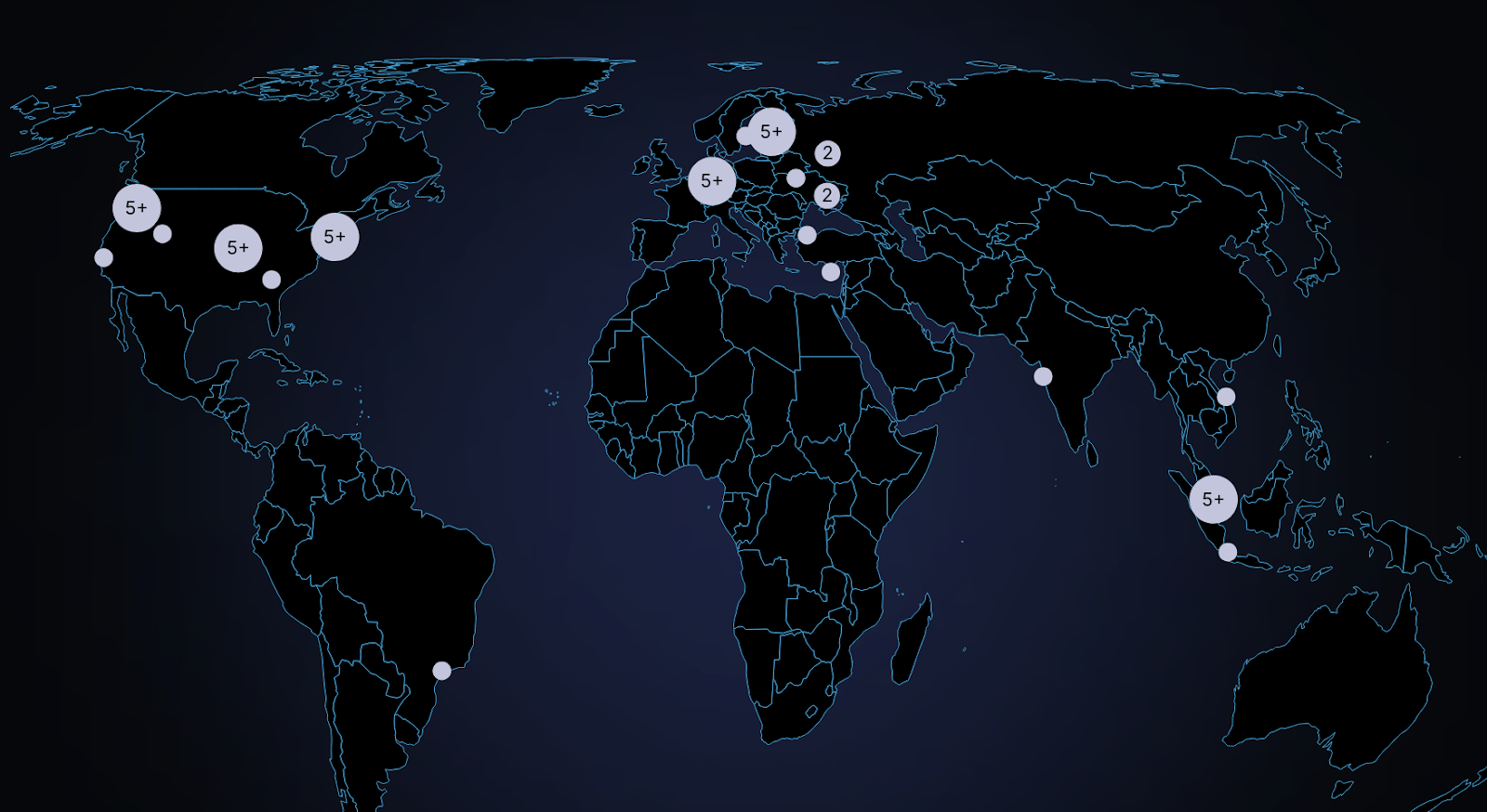
In order to stop the mempool from ejecting transactions, the p2p mempool size was increased. By increasing the mempool size, the likelihood of needing to evict transactions that might soon appear in proposals is reduced. This increases the chances that sequencers already have the necessary transactions locally when they receive a block proposal. As a result, more validators are able to attest to proposals, allowing blocks to be finalized more reliably. Once blocks are included on L1, their transactions are evicted from the mempool. So over time, as more blocks are finalized and transactions are mined, the mempool naturally shrinks and the network will recover on its own.
If you are interested in running a sequencer node visit the sequencer page. Stay up-to-date on Noir and Aztec by following Noir and Aztec on X.
Noir, the universal language for zero-knowledge applications, is now in beta.
Noir was originally created to solve the two-brain problem for ZK circuits: with previous zero knowledge DSL's, developers were required to understand basic cryptography in addition to reasoning about business logic. The way we described it was needing two brains:
After over a year of development since Noir’s alpha release, we’re ready to present a powerful version of Noir that is:
If you’ve thought about Noir but wasn’t sure about it’s stability, now’s the time to dive in. While Noir remains unaudited and we warn against production use-cases involving financial assets, we believe the DevEx and feature-suite are mature.
> Discover Noir with Noir Guardians
> Get started with Noir documentation at noir-lang.org
Noir has never been more fun or usable for writing games, identity solutions, and much more that allow for privacy on-chain:
Noir is designed to be familiar to a wide swath of developers, which is why it’s based on Rust. You won’t feel like you’re learning to program again, you’ll just start programming in ZK.
Abstract Circuit Intermediate Representation (ACIR) allows for multiple crypto-providing backends. Noir is Aztec network friendly, not Aztec network only. Plug into any crypto backend you’d like.
awesome-noir boasts a collection of core cryptographic primitives written by best-in-class cryptographers. Take advantage of what your fellow devs have already built, then pay it forward with your own contributions.
Versioned releases: Noir comes released with numbered versions, providing its users the flexibility to choose and settle on a certain snapshot of the language and freeing developers’ minds from the need to constantly keep track of breaking changes. Refer to GitHub to learn more.
Continuous integration testing: Noir is developed with a comprehensive set of integration tests that minimizes the probability of unintentionally breaking existing features with new features. Refer to GitHub to learn more.
Over the development cycles since Alpha, numerous features were introduced to the Noir language and Noir's tooling, including but not limited to:
UltraPlonk Integration: The UltraPlonk proving backend by Aztec enables fast proving speeds and gives Noir developers access to natively optimized gadgets like Keccak256 and ECDSA signature verifications. This unlocks a variety of use-cases such as ECrecover, Ethereum Storage Proofs, and zkWebAuthn. Read the announcement to learn more. While UltraPlonk is the default, Noir supports integration with any backends where the community has been developing integrations with the likes of Halo2, Gnark, etc.
NoirJS: A Javascript package for building privacy-preserving applications that work in web browsers. This major milestone essentially means you can build user-ready web apps with Noir. Read the announcement to learn more.
Unconstrained Functions: Noir supports the development of unconstrained functions using the same language syntax. This means developers can define and write computations that execute outside of circuits, enabling more highly optimized circuits and programs. Read the announcement to learn more.
VS Code Extension: This extension helps developers write, understand, and improve Noir code with features such as:
Read the announcement and download the extension to start using it.
Extended Grammar: From basic control flow like if-else and for-loops to composite data types like structs and traits, Noir supports a wide set of syntaxes that you may expect coming from other programming languages to ease developers building their zero-knowledge applications. Read the Noir docs to learn more.
Standard Library: Re-use trusted and efficient implementations of common primitives without re-implementing cryptography from scratch. Noir comes with a comprehensive standard library covering primitives for hashing, signature verification, merkle proofs, elliptic curve arithmetics, etc. Developed by world class engineers from Aztec Labs and the Noir community, importable right off the shelf. Read the documentation to learn more.
A Noir workflow consists of three stages: Compilation, Execution and Proving.
Compilation is where the user’s program is converted into a sequence of Abstract Circuit Intermediate Representation (ACIR) opcodes for execution and proving that follows. This is done by the Noir compiler, designed with effective circuit optimizing logic and fast compilation.
Execution is where each opcode is executed and the values that each opcode produces is saved, generating proof inputs for proving that follows. This is done by Noir’s Abstract Circuit Virtual Machine (ACVM), a component within the Noir stack.
Proving is where the saved values along with the sequence of opcodes is sent to a proving backend, which generates a proof of the program being executed with said input values. This is done by the proving backend of choice.
Noir enables developers to write, test and compile optimized circuits easily, where they are then handed over to a proving backend of developers’ choice for blazinging fast proving. The default proving backend is the UltraPlonk-based Barretenberg developed and maintained by Aztec Labs.
A quick reference of proving times of common Noir primitives are detailed as below:

A Noir user flow typically starts from developers compiling and distributing the compiled artifacts as a part of their applications to users, where users then execute the application and prove their execution. Execute and Prove times combined hence represent what application users are expected to experience when interacting with applications built with Noir.
Note that execution times depend largely on the Noir stack, while circuit sizes and prove times depend largely on the proving backend of choice. The results were gathered using Noir v0.21.0 paired with the default UltraPlonk-based Barretenberg proving backend on M3 Macbook Pro.
UltraPlonk-based Barretenberg contains small fixed costs for circuits that are amortized in complex circuits. For example, a Noir program doing 1 Keccak256 hash has a circuit size of 55k constraints, while a program that does 100 Keccak256 hashes has a circuit size of 1.8m constraints, rather than 5.5m constraints. This also applies when primitives are mix-and-matched, not just when the same primitive is used at scale.
Expect different results if a different proving backend is used, or when Barretenberg undergoes a significant change (e.g. upgrading from UltraPlonk to UltraHonk).
As a general reference for cross checking performance of Noir programs not listed above, the compilation, execution and proving times for Noir programs spanning different circuit sizes are detailed below:


The Noir technology stack is the main contributor to compilation and execution times, while the proving backend of choice is the main contributor to proving times.
The benchmarking results were gathered using Noir v0.21.0 paired with the default UltraPlonk-based Barretenberg proving backend on M3 Macbook Pro. Refer to Github for more benchmarking details.
Noir is now entering its Beta phase of maturity for developers to start building applications and projects using the language, but that is far from being the destination.
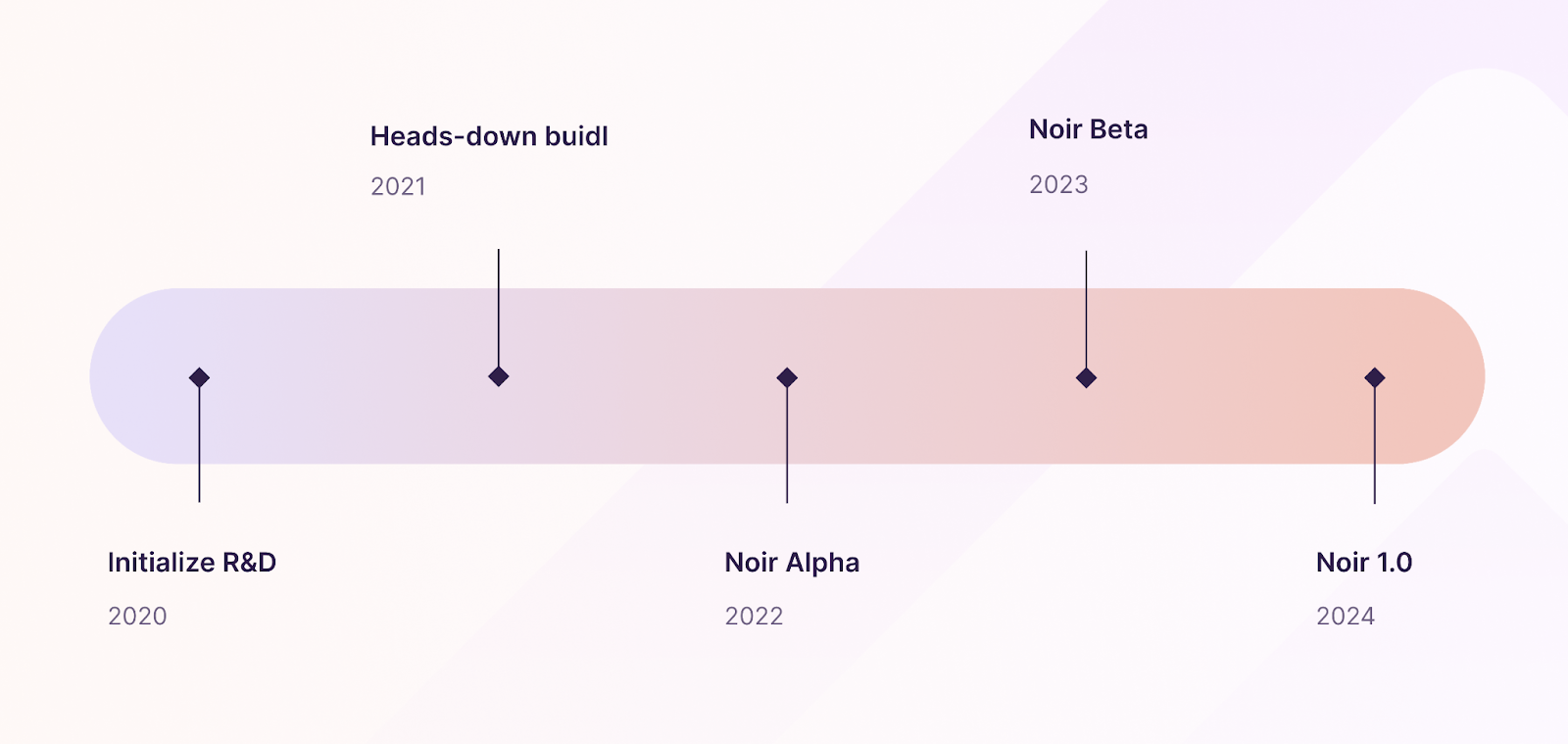
On the road towards production, a vast amount of effort around language features, tooling additions, performance improvements, security audits are continuously being sketched out for the exciting year to come.
If you have been considering developing a Noir project, now is the prime time to start building with the Noir community towards production and launch alongside Noir 1.0.
We’re proud and excited for you to build with Noir Beta as we have ourselves.
We at Aztec Labs have recently completed rebuilding the entirety of Aztec network’s protocol circuits in Noir (read the announcement to learn more). This is the time for your users to experience on-chain privacy via gaming, voting, identities, and so much more.
Learn Noir on Node Guardians today and check resources and projects on Awesome Noir to get started.
Today we are thrilled to announce that Aztec Network has raised $17 million in Series A financing to bring programmable privacy to Web3.
The round was led by Paradigm with support from existing partners a_capital, Ethereal Ventures, and Libertus Capital, and participation from Variant Fund, Nascent, IMToken, Scalar Capital, Defi Alliance, IOSG Ventures, and ZK Validator, along with leading angels including Anthony Sassano, Stani Kulechov, Bankless, Defi Dad, Mariano Conti, and Vitalik Buterin.
“Privacy is a fundamental right. Aztec’s rollup, powered by their pioneering academic research on Plonk, is solving for high privacy while also allowing access to Ethereum’s DeFi. We’re incredibly pleased to partner with them and help advance this work.”
- Georgios Konstantopoulos, Research Partner and Chief Technology Officer, Paradigm
At Aztec we believe decentralization is premised on individual rights. Without widely accessible privacy, we compromise our ability to choose how we live our lives and earn our livelihoods.
That’s why we’re building Aztec Network to deliver privacy without compromise:
“When we started Aztec, the technology to scale blockchains privately didn’t exist. Since then, we’ve assembled a team of world-class cryptographers who continuously redefine the state-of-the-art. Inventing PLONK — the paradigm-defining universal zk-SNARK — showcases our ability to produce technology that matches our ambitions: unlocking an entire universe of blockchain applications that couldn’t exist without privacy.”
- Zac Williamson, CEO and Cofounder, Aztec
Our first product was zk.money, a private transfer protocol built on Aztec. Since launch, zk.money has had over 20,000 registered users, 50,000 transactions, and $35 million in total deposits, all while being 96% cheaper than existing private transfer protocols.
We are now excited to announce Aztec Connect, the first private bridge for Ethereum’s decentralized finance ecosystem. It allows users to confidentially access world-class DeFi services on Ethereum with up to 100x cost savings, all while strengthening Aztec’s existing privacy guarantees.
At launch, Aztec Connect extends the capabilities of zk.money, adding functionality from blue-chip DeFi partners. Soon thereafter, the Connect SDK will allow any Ethereum project to permissionlessly integrate Aztec, unlocking instant privacy and cost-savings.
“We are excited to bring Element’s fixed rates to L2 by integrating with Aztec’s zk-rollup technology. Users will benefit from the same privacy they have come to expect from zk.money with the option to earn fixed rates on their shielded balances, all while saving up to 80–90% in gas fees over L1.”
- Jonny Rhea, CTO and Cofounder, Element Finance
Aztec Connect accomplishes the above while maintaining two significant advantages over other scaling solutions:
“Privacy needs an active financial market to be useful. Aztec Connect was designed with this in mind — its goal is to deliver value to users of existing DeFi protocols by adding iron-clad privacy guarantees and reducing transaction costs.”
- Joe Andrews, Head of Product and Cofounder, Aztec
Proceeds from the Series A will be used for network decentralization, Aztec Connect Grants, and continued development of our class-leading zero knowledge proving systems.
We are grateful for the community of users and developers supporting Aztec’s mission to build the programmable privacy layer for Ethereum and Web3.
To join our community or develop on Aztec Connect, please follow us on Twitter, find us on Discord, and check out the Aztec Connect Starter on Github.
We are always looking for talented and passionate contributors to Aztec. If you’re interested in joining our mission, browse our full time roles here.
Aztec Network is the first private ZK-rollup on Ethereum, enabling decentralized applications to access privacy and scale. Aztec’s rollup is secured by its industry-standard PLONK proving mechanism used by the leading zero-knowledge scaling projects.
For press inquiries please reach out to jon@aztecprotocol.com.
A full media kit can be found here.
How do you benchmark SNARKs?
It’s a problem because different SNARKs will perform differently on various circuits — it’s not a matter of ‘PLONK is 5x faster than Sonic every time’.
Well, a critical measure is how efficiently a SNARK can verify a hash operation. But why are hashes important? This article describes how zero-knowledge assets are stored in the Two-Tree Model, and therefore why fast hashes in SNARKs are mission-critical.
Before explaining how the Two-Tree Model works, here’s a reminder of what a Merkle tree actually is.
Remember, the purpose of a Merkle Tree is to generate a single short digest (hash) of many pieces of data, so that if asked, one can prove that any one piece of data is ‘guaranteed’ by that hash without revealing all the other pieces of data.
In the diagram below, data pieces A, B, C and D are separately hashed. Next, each pair is hashed together (turning 4 hashes into two hashes). Finally, those two hashes are hashed to form the ‘Merkle Root’.
The Merkle Root changes if and only if a single piece of data changes (i.e. if A, B, C or D are modified / edited). Here’s the picture to have in mind:
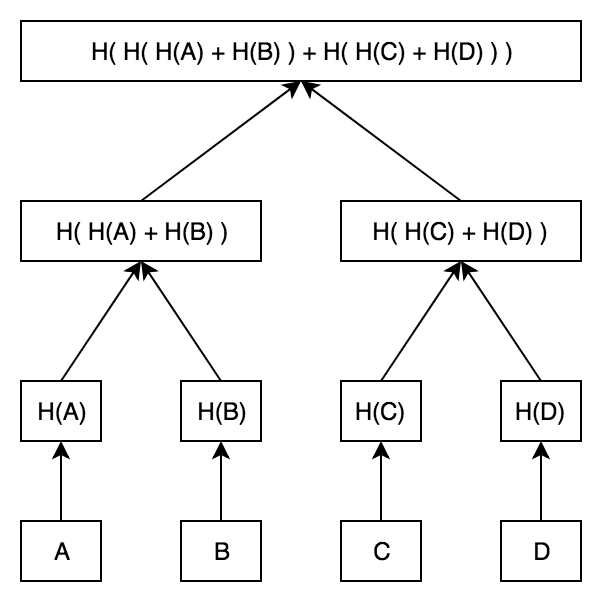
We introduce the classical model for storing ZK Assets.
This system is built around a UTXO model like Bitcoin — i.e. each asset is recorded via so-called ‘notes’ of ownership. An asset with $1,000 total global supply is held in the form of one-or-more notes by each owner.
Alice may hold $10 of this asset in (say) three notes: $7, $2 and $1. Transferring ownership involves a ‘join split’ transaction which takes input notes (e.g. say the $7 and $2 notes above), and printing new output notes (say $8 and $1).
Instead of creating output notes and destroying input notes, we instead record this process in two trees —
The idea is — instead of deleting a note from the Note Tree, you need to check whether that note also turns up in the Nullifier Tree to work out if it’s already spent. If it’s not there, it’s still spendable.
A join-split transaction adds the output notes to the Note Tree, and the input notes to the Nullifier Tree.
Let’s take a closer look at these structures.
Locations in Tree = ~2³⁰ leaves (dense Merkle Tree)
The first tree — the Note Tree — determines the current state of all data inside the system — smart contracts, registers of ownership of assets — everything. For now, let’s focus just on recording the ownership of assets through notes.
Suppose Alice sends Bob 50 zkDai and the Note Tree has slots 1, 2, … n filled up. Then the following is added to the Note Tree:
Encrypt (
{
owner: [Bob's Address], asset: 0x40a5a9872e73de550516d8ec43c6990f8247441d, amount: 50
}
)Locations in Tree = ~2²⁵⁶ leaves (sparse Merkle Tree)
The second tree — the Nullifier Tree — determines which notes have been spent — we add the following to the Nullifier Tree to mark Alice’s Input Note of 50 zkDai as spent.
Hash (
{
owner: [Alice's Address], asset: 0x40a5a9872e73de550516d8ec43c6990f8247441d, amount: 50
}
)
The ‘random’ nature of the Hash means the note in the nullifier set can’t be traced to the newly-added note in the Note Tree.
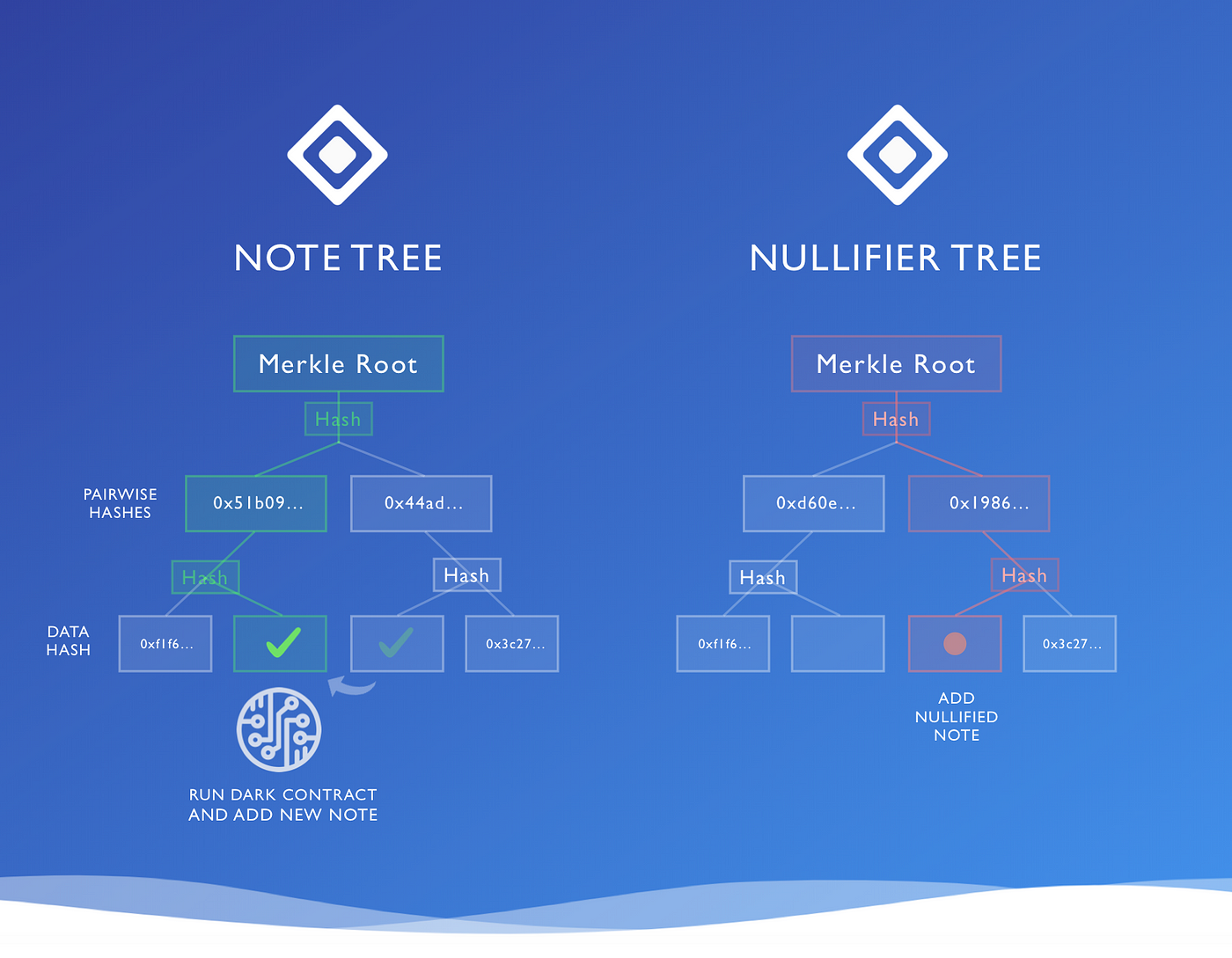
The two-tree diagram above is actually slightly misleading in one respect — it shows the spent note being added to position 3 (out of 4) in the Nullifier Tree, at the same location it was originally created in the Note Tree.
However, these two trees have significantly different structures.
The Note Tree is actually encoded as a ‘dense’ Merkle Tree — that is, a tree designed to hold ~2³⁰ notes, and therefore requiring 30 hashes to add a note. You add the notes in the order in which they are created over the lifetime of the asset— first note at position 1, second note at position 2, etc. This tree is ‘dense’ because leaves are all created as immediate next-door neighbours.
The Nullifier Tree, however, looks very different — addresses, instead of running in order, are determined by the hash of the nullifier note data (detailed above). This of of course means that the Nullifier Tree is a sparse Merkle tree — that is, a tree with 2²⁵⁶ theoretically-available leaves — each containing the number 0. The note is added at the address determined by that hash — that’s right, the note hash’s value *also* doubles as its location in the tree. In other words, the Nullifier Note is placed into the Nullifier Tree amid a wilderness of zeros.
Notice that this means that the position of a note in the Nullifier Tree (i.e. being marked as spent) is ≠ the position in the Note Tree.
There are two excellent reasons for this:
Observation: Even though the Nullifier Tree has 2²⁵⁶ locations, and therefore 256 hashes between a leaf and the Merkle Root, most of the locations always hold the default value 0 (i.e. most locations are unused). This allows us to get the number of hashes needing verification nearer to 30, rather than 256.
The following computation is indicative only — AZTEC is actually going to use more SNARK-friendly hashes e.g. Pedersen commitments.
But to complete the exercise:
Each SHA-256 hash in PLONK requires ~27,000 gates for a 64 byte input, so 60 hashes consume ~1.6m gates. The actual smart-contract logic can often be run in a handful of gates — sometimes 10s, 100s, or 1,000s of gates depending on the smart contract in question.
That leaves hashing algorithms dominating > 99% of the computation. And that is why benchmarking SNARKs on hashing algorithms is the crucial barometer of speed.
We’re on the lookout for talented engineers and applied cryptographers. If joining our mission to bring scalable privacy to Ethereum excites you — get in touch with us at hello@aztecprotocol.com.